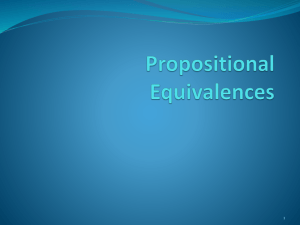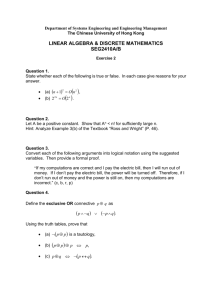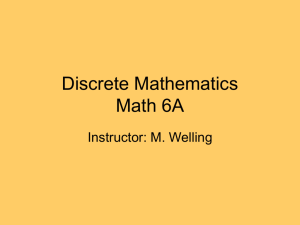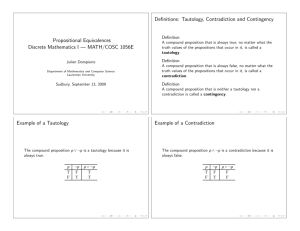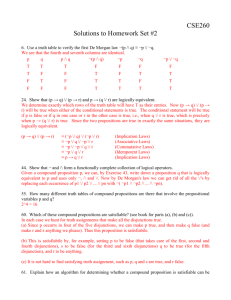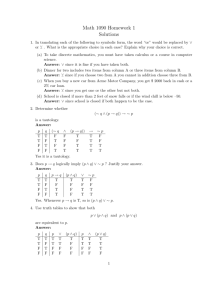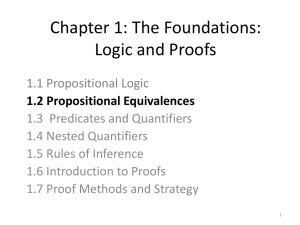Page 1 of 5 Math 3336 Section 1.3 Propositional Equivalences
advertisement
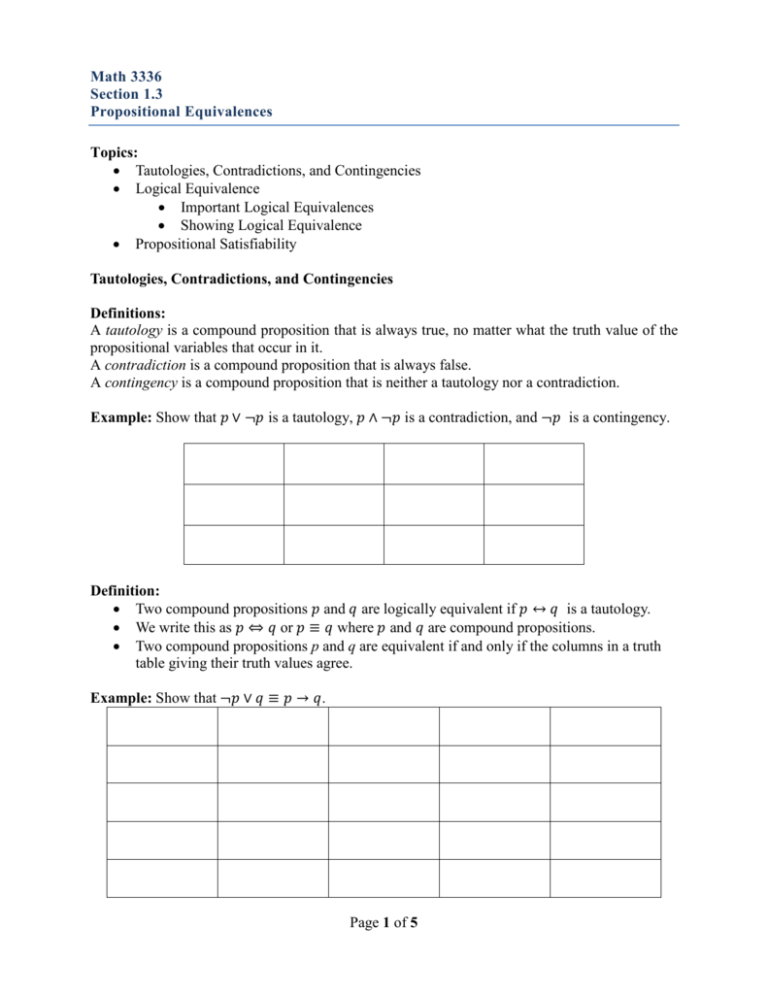
Math 3336 Section 1.3 Propositional Equivalences Topics: • Tautologies, Contradictions, and Contingencies • Logical Equivalence • Important Logical Equivalences • Showing Logical Equivalence • Propositional Satisfiability Tautologies, Contradictions, and Contingencies Definitions: A tautology is a compound proposition that is always true, no matter what the truth value of the propositional variables that occur in it. A contradiction is a compound proposition that is always false. A contingency is a compound proposition that is neither a tautology nor a contradiction. Example: Show that 𝑝𝑝 ∨ ¬𝑝𝑝 is a tautology, 𝑝𝑝 ∧ ¬𝑝𝑝 is a contradiction, and ¬𝑝𝑝 is a contingency. Definition: • Two compound propositions 𝑝𝑝 and 𝑞𝑞 are logically equivalent if 𝑝𝑝 ↔ 𝑞𝑞 is a tautology. • We write this as 𝑝𝑝 ⇔ 𝑞𝑞 or 𝑝𝑝 ≡ 𝑞𝑞 where 𝑝𝑝 and 𝑞𝑞 are compound propositions. • Two compound propositions p and q are equivalent if and only if the columns in a truth table giving their truth values agree. Example: Show that ¬𝑝𝑝 ∨ 𝑞𝑞 ≡ 𝑝𝑝 → 𝑞𝑞. Page 1 of 5 De Morgan’s Laws AUGUST DE MORGAN (1806 - 1871) ¬(𝑝𝑝 ∧ 𝑞𝑞) ≡ ¬𝑝𝑝 ∨ ¬𝑞𝑞 ¬(𝑝𝑝 ∨ 𝑞𝑞) ≡ ¬𝑝𝑝 ∧ ¬𝑞𝑞 Example: Show that the second De Morgan law works. Key Logical Equivalences Page 2 of 5 More Logical Equivalences Example: Establish the distributive law of disjunction over conjunction, i.e. show that 𝑝𝑝 ∨ (𝑞𝑞 ∧ 𝑟𝑟) and (𝑝𝑝 ∨ 𝑞𝑞) ∧ (𝑝𝑝 ∨ 𝑟𝑟) are equivalent. Constructing New Logical Equivalences We can show that two expressions are logically equivalent by writing a series of logically equivalent statements. Page 3 of 5 Example (Equivalence Proof): Show that ¬(𝑝𝑝 ∨ (¬𝑝𝑝 ∧ 𝑞𝑞))is logically equivalent to ¬𝑝𝑝 ∧ ¬𝑞𝑞. Example (Equivalence Proof): Show that (𝑝𝑝 ∧ 𝑞𝑞) → (𝑝𝑝 ∨ 𝑞𝑞) is a tautology. Propositional Satisfiability Definition: A compound proposition is satisfiable if there is an assignment of truth values to its variables that make it true. When no such assignments exist, the compound proposition is unsatisfiable. • A compound proposition is unsatisfiable if and only if its negation is a tautology. Page 4 of 5 Example: Determine the satisfiability of the following compound proposition (𝑝𝑝 ∨ ¬𝑞𝑞) ∧ (𝑞𝑞 ∨ ¬𝑟𝑟) ∧ (𝑟𝑟 ∨ ¬𝑝𝑝) Hint: Assign T to 𝑝𝑝, 𝑞𝑞, and 𝑟𝑟. Page 5 of 5

